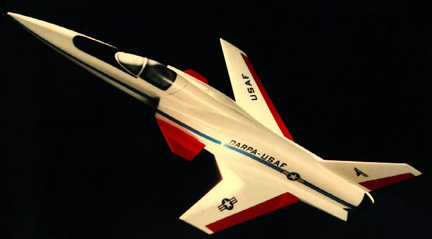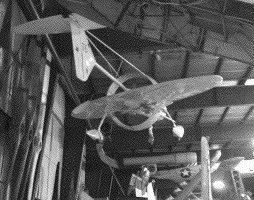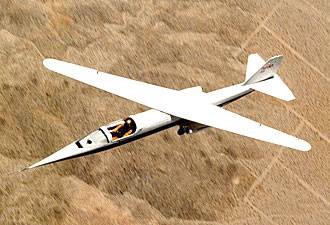Propellers
Airplane propellers act like small rotating wings, whose "lift" pulls the airplane forward (the pulling force is known as thrust). Possibly the greatest benefit derived by the Wright brothers from their wind tunnel was the help they got, not in planning their wings (a crude design, limited by available technology) but in the design of their propellers, which were twice as efficient as any others of their time.
Again, it is more convenient to regard the propeller as static and the air as moving. It is also permissible to ignore the fact that propeller blades move around a circle, by considering only a short segment of that circular motion, over which the motion is nearly in a straight line.
(Note however that each part of the propeller blade moves with a different speed. One should divide the propeller into sections, each with its distance from the central shaft, and study separately the forces on each section. Here let us concentrate on the tip sections of the blades, whose velocity v1 is the greatest and which therefore generate the greatest thrust.)
What complicates the situation is that the airplane itself, too, is moving.. Again, this can be studied from the frame of the airplane, which sees the air rushing towards it with some velocity v2. From the frame of the blade-tip (top drawing), air is blowing at it with a velocity consisting of two mutually perpendicular components, v1 due to its own motion and v2 due the the airplane's forward motion.
Consider the propeller's action before the airplane begins to move (v2=0). The lift L on the blade, which provides the airplane's thrust, is perpendicular to the blade's motion (or nearly so), and pulls the airplane straight ahead, as is required.
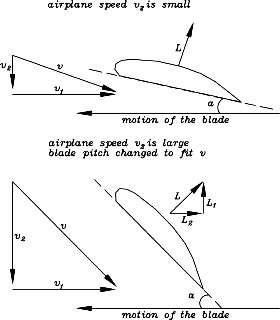 Next suppose the airplane is flying at a moderate velocity v2. Now the propeller no longer senses a head-on velocity v1, but a velocity v hitting the blade at an angle slanting from the front (top of the figure). This was not a serious problem in the earliest airplanes, because they flew rather slowly. For them v2 was always much smaller than v1, and a one-piece metal or wooden propeller, with its blade slightly rotated to face v at the airplane's usual cruising speed (or slighly more, to provide a small angle of attack), worked quite well at other speeds, too. Many small airplanes today still use such propellers.
Next suppose the airplane is flying at a moderate velocity v2. Now the propeller no longer senses a head-on velocity v1, but a velocity v hitting the blade at an angle slanting from the front (top of the figure). This was not a serious problem in the earliest airplanes, because they flew rather slowly. For them v2 was always much smaller than v1, and a one-piece metal or wooden propeller, with its blade slightly rotated to face v at the airplane's usual cruising speed (or slighly more, to provide a small angle of attack), worked quite well at other speeds, too. Many small airplanes today still use such propellers.
Faster airplanes, however, need propellers with adjustable blades, able to increase the angle ("pitch") at which they "bite" into the air as the flight speed increases, so that they always face into the combined velocity v due to their own motion and that of the airplane. One can not compensate by increasing the speed v1 of the blade, because as the propeller tips reach the speed of sound, their efficiency drops markedly (and the noise they produce rises!)
Adjustable blades ("variable pitch propellers"), more expensive and complicated than one-piece propellers, have long been standard equipment on the faster propeller airplanes. But even they hit a limit. Suppose the airplane moves at the same speed as the propeller tip, that is, v2 = v1. The tip of the blade then needs to be rotated into the direction of motion by 45 degrees into the direction of motion (bottom drawing). Two disturbing trends now become evident.
First of all, as seen from the "vector addition triangle" and the theorem of Pythagoras, the total velocity v sensed by the blade is considerably faster (by about 41%) than either of its two component velocities, pushing it closer to the speed of sound and its associated problems. And secondly, the lifting force L on the blade is also rotated by 45 degrees! Only the component L1 pulls the airplane forward--the other component, L2, actually opposes the rotation of the propeller and demands extra power from the motor, power that serves no useful purpose.
Because of such problems, propeller-driven airplanes have never even approached the speed of the jets. The faster propeller-driven fighter airplanes of World War II flew at about 370-400 mph. The speed record for a purely propeller-driven airplane, 463 mph, was attained in Germany before the war (in 1939) and stood for decades. The current record is 528.33 mph, attained in 1989 by the "Rare Bear", a WW-II US Navy 8F8 "Bearcat" fighter, modified for high-speed racing. The airplane had crashed in 1962 and was lying in an Indiana cornfield, next to a runway, before Lyle Shelton in 1969 found it and restored it. He later replaced its 2400 HP engine with one of 4000 HP (getting less than 1 mile per gallon gas at top speed), replaced its propeller, and trimmed its weight. It is still flying. (Thanks to Dr. Eddie Irani for this information).
And by the way...
Wings on jet airplanes are swept back, to reduce the velocity component flowing perpendicular to the wing. Couldn't the same effect be produced by sweeping the wings forward? It is possible and was done on NASA's X-29 experimental aircraft (pictured below; more about it,  Any object immersed in a fluid (in air or water, for instance) experiences a pressure on all its surfaces, a force on each unit of area due to the weight of air or water stacked up above it (even if that surface faces sideways or down). In the absence of motion--e.g. when the airplane is standing on the runway--a wing experiences equal pressure on its top and bottom, and therefore tends to move neither up nor down.
Any object immersed in a fluid (in air or water, for instance) experiences a pressure on all its surfaces, a force on each unit of area due to the weight of air or water stacked up above it (even if that surface faces sideways or down). In the absence of motion--e.g. when the airplane is standing on the runway--a wing experiences equal pressure on its top and bottom, and therefore tends to move neither up nor down.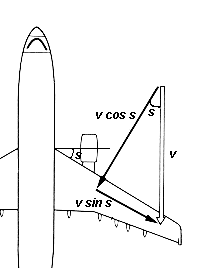 At the speed of sound, the air resistance ("drag") increases steeply, because air cannot get out of the way fast enough and therefore becomes compressed and heated. Heat is a form of energy, and to produce it, something else has to give up energy--in this case, it is the motion, producing increased drag; the "lift" of the wing also suffers. Actually, those problems begin well before the speed of sound is reached, because part of the flow above a wing has extra speed and can reach that speed even before the airplane does.
At the speed of sound, the air resistance ("drag") increases steeply, because air cannot get out of the way fast enough and therefore becomes compressed and heated. Heat is a form of energy, and to produce it, something else has to give up energy--in this case, it is the motion, producing increased drag; the "lift" of the wing also suffers. Actually, those problems begin well before the speed of sound is reached, because part of the flow above a wing has extra speed and can reach that speed even before the airplane does. Next suppose the airplane is flying at a moderate velocity v2. Now the propeller no longer senses a head-on velocity v1, but a velocity v hitting the blade at an angle slanting from the front (top of the figure). This was not a serious problem in the earliest airplanes, because they flew rather slowly. For them v2 was always much smaller than v1, and a one-piece metal or wooden propeller, with its blade slightly rotated to face v at the airplane's usual cruising speed (or slighly more, to provide a small angle of attack), worked quite well at other speeds, too. Many small airplanes today still use such propellers.
Next suppose the airplane is flying at a moderate velocity v2. Now the propeller no longer senses a head-on velocity v1, but a velocity v hitting the blade at an angle slanting from the front (top of the figure). This was not a serious problem in the earliest airplanes, because they flew rather slowly. For them v2 was always much smaller than v1, and a one-piece metal or wooden propeller, with its blade slightly rotated to face v at the airplane's usual cruising speed (or slighly more, to provide a small angle of attack), worked quite well at other speeds, too. Many small airplanes today still use such propellers.